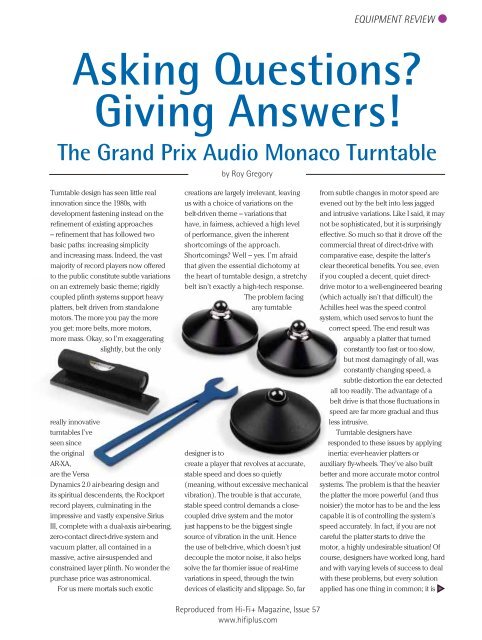Roy-Gregorys-Review-of-the-Monaco-Turntable
Roy-Gregorys-Review-of-the-Monaco-Turntable
Roy-Gregorys-Review-of-the-Monaco-Turntable
Create successful ePaper yourself
Turn your PDF publications into a flip-book with our unique Google optimized e-Paper software.
EQUIPMENT REVIEW<br />
Asking Questions?<br />
Giving Answers!<br />
The Grand Prix Audio <strong>Monaco</strong> <strong>Turntable</strong><br />
<strong>Turntable</strong> design has seen little real<br />
innovation since <strong>the</strong> 1980s, with<br />
development fastening instead on <strong>the</strong><br />
refinement <strong>of</strong> existing approaches<br />
– refinement that has followed two<br />
basic paths: increasing simplicity<br />
and increasing mass. Indeed, <strong>the</strong> vast<br />
majority <strong>of</strong> record players now <strong>of</strong>fered<br />
to <strong>the</strong> public constitute subtle variations<br />
on an extremely basic <strong>the</strong>me; rigidly<br />
coupled plinth systems support heavy<br />
platters, belt driven from standalone<br />
motors. The more you pay <strong>the</strong> more<br />
you get: more belts, more motors,<br />
more mass. Okay, so I’m exaggerating<br />
slightly, but <strong>the</strong> only<br />
really innovative<br />
turntables I’ve<br />
seen since<br />
<strong>the</strong> original<br />
AR-XA,<br />
are <strong>the</strong> Versa<br />
Dynamics 2.0 air-bearing design and<br />
its spiritual descendents, <strong>the</strong> Rockport<br />
record players, culminating in <strong>the</strong><br />
impressive and vastly expensive Sirius<br />
III, complete with a dual-axis air-bearing,<br />
zero-contact direct-drive system and<br />
vacuum platter, all contained in a<br />
massive, active air-suspended and<br />
constrained layer plinth. No wonder <strong>the</strong><br />
purchase price was astronomical.<br />
For us mere mortals such exotic<br />
by <strong>Roy</strong> Gregory<br />
creations are largely irrelevant, leaving<br />
us with a choice <strong>of</strong> variations on <strong>the</strong><br />
belt-driven <strong>the</strong>me – variations that<br />
have, in fairness, achieved a high level<br />
<strong>of</strong> performance, given <strong>the</strong> inherent<br />
shortcomings <strong>of</strong> <strong>the</strong> approach.<br />
Shortcomings? Well – yes. I’m afraid<br />
that given <strong>the</strong> essential dichotomy at<br />
<strong>the</strong> heart <strong>of</strong> turntable design, a stretchy<br />
belt isn’t exactly a high-tech response.<br />
The problem facing<br />
any turntable<br />
designer is to<br />
create a player that revolves at accurate,<br />
stable speed and does so quietly<br />
(meaning, without excessive mechanical<br />
vibration). The trouble is that accurate,<br />
stable speed control demands a closecoupled<br />
drive system and <strong>the</strong> motor<br />
just happens to be <strong>the</strong> biggest single<br />
source <strong>of</strong> vibration in <strong>the</strong> unit. Hence<br />
<strong>the</strong> use <strong>of</strong> belt-drive, which doesn’t just<br />
decouple <strong>the</strong> motor noise, it also helps<br />
solve <strong>the</strong> far thornier issue <strong>of</strong> real-time<br />
variations in speed, through <strong>the</strong> twin<br />
devices <strong>of</strong> elasticity and slippage. So, far<br />
Reproduced from Hi-Fi+ Magazine, Issue 57<br />
www.hifiplus.com<br />
from subtle changes in motor speed are<br />
evened out by <strong>the</strong> belt into less jagged<br />
and intrusive variations. Like I said, it may<br />
not be sophisticated, but it is surprisingly<br />
effective. So much so that it drove <strong>of</strong>f <strong>the</strong><br />
commercial threat <strong>of</strong> direct-drive with<br />
comparative ease, despite <strong>the</strong> latter’s<br />
clear <strong>the</strong>oretical benefits. You see, even<br />
if you coupled a decent, quiet directdrive<br />
motor to a well-engineered bearing<br />
(which actually isn’t that difficult) <strong>the</strong><br />
Achilles heel was <strong>the</strong> speed control<br />
system, which used servos to hunt <strong>the</strong><br />
correct speed. The end result was<br />
arguably a platter that turned<br />
constantly too fast or too slow,<br />
but most damagingly <strong>of</strong> all, was<br />
constantly changing speed, a<br />
subtle distortion <strong>the</strong> ear detected<br />
all too readily. The advantage <strong>of</strong> a<br />
belt drive is that those fluctuations in<br />
speed are far more gradual and thus<br />
less intrusive.<br />
<strong>Turntable</strong> designers have<br />
responded to <strong>the</strong>se issues by applying<br />
inertia: ever-heavier platters or<br />
auxiliary fly-wheels. They’ve also built<br />
better and more accurate motor control<br />
systems. The problem is that <strong>the</strong> heavier<br />
<strong>the</strong> platter <strong>the</strong> more powerful (and thus<br />
noisier) <strong>the</strong> motor has to be and <strong>the</strong> less<br />
capable it is <strong>of</strong> controlling <strong>the</strong> system’s<br />
speed accurately. In fact, if you are not<br />
careful <strong>the</strong> platter starts to drive <strong>the</strong><br />
motor, a highly undesirable situation! Of<br />
course, designers have worked long, hard<br />
and with varying levels <strong>of</strong> success to deal<br />
with <strong>the</strong>se problems, but every solution<br />
applied has one thing in common; it is



